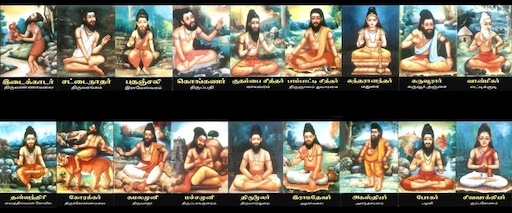
18 Siddhars
Siddhar (Tamil: சித்தர் cittar, from Sanskrit: siddha)[2] in the Tamil tradition, describes a self-realised human being, who has attained spiritual powers called Siddhis. Their main objective however, was to experience Sivam, the supreme consciousness, in their respective human frame, and share this knowledge with others, interested in following their path.
Historically, the term Siddhar referred to individuals who chose at a young age, to become wandering ascetics and mendicants. They dominated the ancient Tamil academic landscape with regards to health, alchemy and philosophy. The Siddhars were iconoclastic philosophers and scientists, whose ideas and views challenged the norms of the time, and still do today.[3] They were knowledgeable in science, technology, astronomy, literature, fine arts, music, drama and dance. They provided various solutions to remedy ailments and illness amongst the population, as well as advice for future generations to come.[4] Most of their ideologies have their origins in the First Sangam period.[5][6][7]
Siddhars were typically potters, goldsmiths, blacksmiths, merchants and shepherds. They chose, during the course of their lives, to relinquish the material and live as wandering ascetics, in the quest to experience the supreme consciousness and to ponder life’s mysteries. By virtue of their austere penance, they developed Siddhis, but these were and are distractions on the path. They later returned as poets, saints, scientists, physicians and alchemists to share their knowledge with everyone, irrespective of creed or caste. They wrote down their findings in the form of cryptic Tamil poetry on to palm leaf manuscripts. These manuscripts are still owned by some families in Tamil Nadu and are handed down through the generations. Some are kept at universities in India, Germany, Great Britain, and the United States.[8] There is an overall reluctance to translate these manuscripts and share this knowledge with a wider audience; possibly to control the dissemination of this knowledge, to present their biased views, using only their interpretation to support said views.
The Siddhars developed the Siddhar medicine system, the oldest traditional system of healthcare originating in India. The basic tenets of this system for healthy living, are food and lifestyle. It is a holistic and sustainable way of delivering healthcare, as it is largely preventative and focused on rejuvenation and prolongation. There is a common saying amongst those familiar with this system, ‘Food is medicine and medicine is food’.[9] A rustic form of healing, inspired by the Siddhar medicine system, continues to be practiced today, by experienced elders in the villages of Tamil Nadu, referred to as “Paatti Vaitthiyam” (grandmother’s medicine) “Naattu Marunthu” (folk medicine) and “Mooligai Marutthuvam” (herbal medicine).
Siddhars are also believed to be the founders of Varma Kalai, a martial art used for self-defense. It can also be harnessed as a form of medical treatment, depending on how it is applied. Varmam, are vital energy points located in the human body which serve as concentrations of life energy,[10] the manipulation of which, can produce various results, such as disabling an attacker for self-defense, or for mitigating a physical condition as an easy first-aid medical treatment in the field.
The Siddhars were first to develop pulse-reading (“naadi paarththal”) to identify the origin of illnesses and physical conditions.
The Siddhars wrote many such cryptic Tamil poems pertaining to our human existence, as well as describing alchemical processes. It is believed that most of them have lived for centuries, if not millenia, in and out of states of samadhi. Their base of operations was Sathuragiri, a mountain range near Thaaniparai village in Tamil Nadu, which pilgrims frequent to this day.